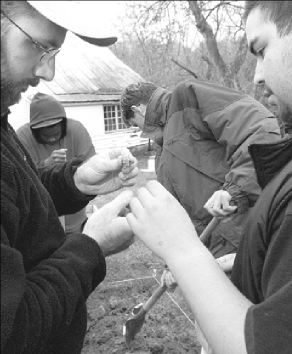|
Before the water line can go in for the new jail in
Clarksburg, Last week, they got some help in digging around the grounds
of "We're looking for anything that has anything to do with
this Badgeley sat on an overturned paint bucket, carefully using
a "Yesterday we found some white ware [pottery or glass],
... They also found a cow's tooth and bone. Before the work began, archaeologist Elizabeth Anderson |
 |
|
Tom Fedor/The Gazette Brian Lione, left, a staff archaeologist with Elizabeth Anderson Comer Archaeology, talks with Francisco Diaz, 15, of the Kingsley Wilderness School to identify an object he found at the dig at the site of the new county jail in Clarksburg. Students from the school helped check for historically significant items. |
"I'm looking for arrowheads, sharpened stuff," said
Darnell Gilliard, 16, reaching into a bag and pulling out what
may have
been a knife used by Native Americans.
The first land grant to include the Moneysworth Farm is dated 1765, Comer said. The survey and patent showed a farm of 796 acres owned by John Belt. The farm stretched on both sides of what is now I-270.
"I found a clinker," said Tony Ahrens, 14.
A clinker is an old piece of coal that did not fully burn in a wood-burning stove and was thrown away in the garden.
Ahrens was sitting on an overturned paint bucket sifting for more items.
Archaeologists Comer and Brian Lione marked what they figure was the fence line around the garden with orange flags. The students then dug test pits.
"People would pile debris along the fence line," she said.
While some of the boys dug test holes two feet deep, others sat at the screens sifting the dirt and others were under a tent washing the items collected in the bags.
A group of eight boys volunteered at the site for most of the week. Other Kingsley students took turns visiting the site.
Comer and Lione watched as the students worked. They patiently examined each potential artifact held up for them to see. After a day or two of digging, the students were adept at telling the difference between a carved piece of rock and an ordinary rock or piece of clay.
"It's more fun to have somebody else see it for the first time," Comer said. "If you can feel you're touching stuff that nobody's touched since it's been laid down, there's a connection there."
The Kingsley School was on the Moneysworth Farm grounds until it was moved three miles away last year, when crews began preparing the jail site. The school will move back on the site when the jail construction is finished.
When the school opened in 1978, much of the area surrounding it was a sludge dump.
"Our mission was to reclaim the earth, to be environmental stewards," Jewell said. "Our mission is now broadened to be stewards of the cultural heritage. This is a great introductory activity to connect ourselves with the history."
Student involvement in the archaeological dig was always part of the plan, said project manager Sandra Batterden.
"The opportunity just can't be passed up for the kids," she said.
State and federal law protects cultural and historic resources, so the dig was required, she said.
An earlier dig before the road was built did not find anything significant.